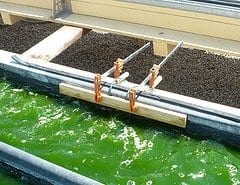
Researchers at the Pacific Northwest National Laboratory have found that nearly 14 percent of land in the continental United States, or roughly the combined area of Texas and New Mexico, could be used for converting algae to transportation fuels.
In 2008, the U.S. Department of Energy estimated that for algae fuel to replace all the petroleum fuel in the U.S., it would require about 30,000 square kilometers of land, or about half the land area of South Carolina. Therefore, this finding illustrates the potential of algae-based fuels, and for that matter, the potential any alternative energy source that requires vast amounts of land.
“Our main driver was to look at how much land would be available for installing large algae pond systems,” said Dr. Erik Venteris, a spatial modeling engineer at the Pacific Northwest National Laboratory and the lead investigator of the study.
Algae pond facilities require between 1,000 and 1,200 acres of land for one facility, said Venteris. The facilities he envisions would hold up to one million gallons of algae biodiesel per facility.
Where the 14 percent of available land is located is a major concern, however, according to Dr. Richard Nelson, a professor in the Center for Sustainable Energy at Kansas State University. This number includes low-slope, non-protected land. Much of the desert land in Arizona and other parts of the southwest are flat and available, but the amount of infrastructure and resources available in these areas remains a question mark.
Venteris’s study took into account not only areas that were currently available with a low-slope, but also areas that would be cheap to purchase from their current owners.
“The first candidates that I think about are where we have agricultural land that is no longer productive,” said Dr. Stephen Mayfield, the director of the University of California, San Diego’s Algae Center for Biotechnology.
Mayfield said there is tons of agricultural land sitting idle because it has been “salted out” of production. These unproductive lands would be more valuable holding algae facilities, and Mayfield cites California’s Imperial Valley as a good site for algae ponds since its only current use is storing agricultural runoff, and algae can grow in both ocean and wastewater. However, lands in California have some of the highest prices of acquisition, according to Venteris’s study.
The cheapest land that Venteris found was the arid lands in the West, but two types of land stood out to him as good contenders for algae biofuel facilities: marginal croplands and southern woodlands.
The Latest Bing News on:
Algae Biofuels
- GCMD Progress Report Ongoing Series of Marine Biofuel Trialson April 25, 2024 at 4:28 pm
Klean provides pyrolysis & gasification systems that convert rubber tires, scrap plastics & municipal solid waste into electricity and fuels.
- Algae Products Market: Carotenoids and Blue-Green Algae See Strong Growthon April 23, 2024 at 6:30 am
The Algae Products Market is Booming and is Expected to Reach $7.3 Billion by 2028 at a compound annual growth rate [CAGR] of 6.4%!Chicago, April 23, 2024 (GLOBE NEWSWIRE) -- The algae products market ...
- Biorefinery Market Soars To USD 296.31 Billion By 2031 With A CAGR Of 8.61% – Comprehensive Analysis And Growth Insights From 2024-2031on April 21, 2024 at 12:23 am
SNS Insider has projected a CAGR of 8.61%, the biorefinery market size is anticipated to reach over $296.31 billion by the year 2031.
- How A Former Enron Exec Lured ExxonMobil To Bet $150 Million On A Longshot Biofuelon April 19, 2024 at 3:30 am
Richard Palmer of Global Clean Energy used Exxon money to overhaul an aging California oil refinery in order to process the oil-rich seeds of a plant called camelina. Now Exxon is suing.
- More than fertilizer for farm fieldson April 16, 2024 at 5:01 pm
It also uses microalgae that extracts nutrients from the manure, which can then be used to produce animal feed and biofuels ... nutrients in manure to produce algae and to help grow hydroponic ...
- DOH issues blue-green algae advisory for Caloosahatchee River. Where else are blooms?on April 16, 2024 at 8:24 am
A blue-green algae outbreak in the Caloosahatchee River appears to be spreading as the state issued more contact advisories Friday. The Florida Department of Health in Lee County issued an ...
- At CERAWeek, biofuels are the solutionon April 11, 2024 at 5:00 pm
Recently, I was delighted to sit on the “Business Models to Scale Biofuels” panel at CERAWeek. My message to attendees—which included United States government officials, investors ...
- US government to award $18.8m for algae biomass researchon April 11, 2024 at 2:48 am
The U.S. Department of Energy’s Bioenergy Technologies Office (BETO) and Office of Fossil Energy and Carbon Management (FECM) have released the MACRO: Mixed Algae Conversion Research Opportunity ...
- Remove green algae from garden fences with expert's 'effective' 35p trickon April 8, 2024 at 6:05 am
Garden algae can wreak havoc and look unsightly in your garden, so you'll no doubt want to banish it just in time for the months when you'll be spending lots of time outside. Speaking to The ...
- SFCC biofuels team among finalists in nationwide algae competitionon April 3, 2024 at 5:02 pm
the college's algae cultivation program takes a hands-on approach to teaching students how to farm algae on a large scale, later used to produce biofuels, nutritional supplements and other products, ...
The Latest Google Headlines on:
Algae Biofuels
[google_news title=”” keyword=”Algae Biofuels” num_posts=”10″ blurb_length=”0″ show_thumb=”left”] [/vc_column_text]The Latest Bing News on:
Algae biofuel facilities
- Earth Day 2024 report card: Experts address America's climate change actionon April 23, 2024 at 1:31 pm
As the effects of climate change come knocking at American doors, experts say U.S. lawmakers can no longer rely on crisis response measures and must take action.
- Provo aiming to clean up Utah Lake with state-of-the-art wastewater treatment facilityon April 23, 2024 at 11:55 am
Water will start being put through the plant in early fall so the facility can be tested before it starts processing sewage at the end of March 2025.
- US government to award $18.8m for algae biomass researchon April 11, 2024 at 2:48 am
The U.S. Department of Energy’s Bioenergy Technologies Office (BETO) and Office of Fossil Energy and Carbon Management (FECM) have released the MACRO: Mixed Algae Conversion Research Opportunity ...
- SFCC biofuels team among finalists in nationwide algae competitionon April 2, 2024 at 4:59 pm
That was the question on Lance Miller’s mind when he learned that, in addition to classrooms, lab spaces and Ethyl the whale, Santa Fe Community College was home to some 10 barrels of the used ...
- Green Energy Biofuel of Aiken County celebrates growth, new machineon March 11, 2024 at 10:06 am
"Bio Joe" Renwick, the cofounder and co-owner of Green Energy BioFuel, spoke about the company Tuesday morning before giving tours of its facility located at 2110 Main St. in Warrenville.
- Isis sugar mill plans to use wastewater to grow algae for human food and fuelon November 12, 2023 at 4:26 pm
And unlike some other biofuels, growing algae doesn't compete for space with ... allows that water to be reused in a process within the facility," he said. Water that did run off would be cleaner ...
- As Exxon bows out, industry takes step toward sustainable algae biofuelson May 9, 2023 at 12:09 pm
An algae biofuel gold rush and financial frenzy was ... Likewise, Viridos systems, including the firm’s California Advanced Algal Facility (CAAF) in Calipatria, are located on what Fetzer ...
- Biotech's green gold?on March 10, 2023 at 9:36 pm
Algae have long been touted as a rich and ... The company collected tens of millions of dollars from investors, but the biodiesel facilities never materialized. A group of investors, a marketing ...
- Newton High School seniors experiment with algae's viability as a biofuelon November 11, 2022 at 2:32 pm
For instance, a large-scale production facility would be needed. There is also a stage between algae growth and the creation of biodiesel — the oil extraction — that would need its own ...
- Creating a Net-Zero Worldon October 5, 2022 at 9:34 pm
New technologies are even emerging to collect carbon dioxide and transform it into beneficial products, from algae biofuels to building ... capture and storage facility in Alberta, Canada.
The Latest Google Headlines on:
Algae biofuel facilities
[google_news title=”” keyword=”algae biofuel facilities” num_posts=”10″ blurb_length=”0″ show_thumb=”left”]










